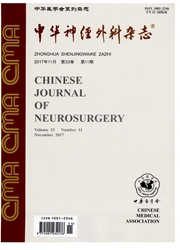

 中文摘要:
中文摘要:
为了探索 thalamic 出血的 6 月的临床的结果的预言者,并且如果最低限度地侵略的 thalamic hematoma 排水(THD ) 能与自发的 thalamic 改进它 54 个病人的 prognosis.MethodsA 总数,评估,出血回顾地被评估。包括人口分布,击风险因素, neuroimaging 变量,承认上的格拉斯哥昏迷分数(GCS ) ,外科的策略,和结果,临床的数据是镇定的。临床的结果用修改 Rankin 规模被估计,六 ? 在发作以后的月。 Univariate 分析和 multivariate 逻辑回归分析被执行决定差的 outcome.ResultsConservative 治疗的预言者为五个病人(9.3%)被执行,为 20 个病人(37.0%)的外部室的排水( EVD ),为四个病人(7.4%)的 THD ,并且 EVD 为 25 个病人(46.3%)与 THD 结合了。在在发作以后的六个月, 21 (38.9%) 病人们完成了有利结果,当(61.1%) 33 有差的结果时。在 univariate 分析,差的 6 月的结果的预言者是承认上的更低的 GCS (P = 0.001 ) ,更大的 hematoma 体积(P < 0.001 ) ,中线移动(P = 0.035 ) ,急性脑水肿(P = 0.039 ) ,并且没有 THD (P = 0.037 ) 。差的结果的独立预言者,根据 multivariate 逻辑回归分析,不是 volume.ConclusionsMinimally 侵略的 THD,在一些天以内移开大多数 hematoma,改进了的 THD 和更大的 hematoma thalamic 的 6 月的结果出血。因此, THD 能广泛地被使用与 thalamic 出血对待病人。
 英文摘要:
英文摘要:
Objective To explore predictors of the 6-month clinical outcome ofthalamic hemorrhage, and evaluate if minimally invasive thalamic hematoma drainage (THD) could improve its prognosis. Methods A total of 54 patients with spontaneous thalamic hemorrhage were evaluated retrospectively. Clinical data, including demographics, stroke risk factors, neuroimaging variables, Glasgow Coma Score (GCS) on admission, surgical strategy, and outcome, were collected. Clinical outcome was assessed using a modified Rankin Scale, six months after onset. Univariate analysis and multivariate logistic regression analysis were performed to determine predictors of a poor outcome. Results Conservative treatnaent was performed for five patients (9.3%), external ventricular drainage (EVD) for 20 patients (37.0%), THD for four patients (7.4%), and EVD combined with THD for 25 patients (46.3%). At six months after onset, 21 (38.9%) patients achieved a favorable outcome, while 33 (61.1%) had a poor outcome. In the univariate analysis, predictors of poor 6-month outcome were lower GCS on admis- sion (P = 0.001), larger hematoma volume (P 〈 0.001), midline shift (P = 0.035), acute hydrocephalus (P = 0.039), and no THD (P = 0.037). The independent predictors of poor outcome, according to the multivariate logistic regression analysis, were no THD and larger hematoma volume. Conclusions Minimally invasive THD, which removes most of the hematoma within a few days, with limited damage to perihematomal brain tissue, improved the 6-month outcome of thalamic hemorrhage. Thus, THD can be widely applied to treat patients with thalamic hemorrhage.
 同期刊论文项目
同期刊论文项目
 同项目期刊论文
同项目期刊论文
 期刊信息
期刊信息
